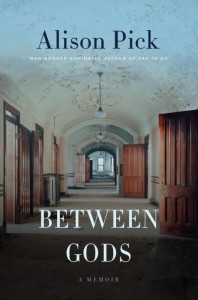October 11, 2014
The Freedom in American Songs by Kathleen Winter
 In the latest issue of Quill and Quire, writer and editor John Metcalf writes of the short story that it “does not translate us to another world; it drives us deeper into this one.” Depth being the object, rather than anything sweeping. As a reader, an advantage of the short story over the novel is one can read it once, and then promptly read it again, “read it again” being the best advice to anyone complaining about a short story being over too soon, about being left wanting to know what happens next. That reader so intent on what happens next, it might be suggested, is focusing on all the wrong details—what’s outside of the story rather than what is within. It’s a curious perspective. But I understand it, in part.
In the latest issue of Quill and Quire, writer and editor John Metcalf writes of the short story that it “does not translate us to another world; it drives us deeper into this one.” Depth being the object, rather than anything sweeping. As a reader, an advantage of the short story over the novel is one can read it once, and then promptly read it again, “read it again” being the best advice to anyone complaining about a short story being over too soon, about being left wanting to know what happens next. That reader so intent on what happens next, it might be suggested, is focusing on all the wrong details—what’s outside of the story rather than what is within. It’s a curious perspective. But I understand it, in part.
I understand it, in part, because I too like sweeping, especially when I’m turning the pages of a book. The short story collection often lacks momentum, its stories not necessarily meant to be read one after the other, each one considered singularly instead. But it’s a book after all, and its service then is less for the reader than for the stories themselves—a thoroughly worthy mission, to deliver them from ephemera. And deliver them to the reader too, yes, but we like one page to lead to another. An unlinked short story collection can be a bumpy road, so it helps when the stories are good, as is the case of The Freedom in American Songs by Kathleen Winter (and edited by John Metcalf, no less).
My favourite story in this collection was “Flyaway”, a bizarre, twisted story of motherhood from the perspective of a woman who is not a mother and therefore has a most objective point of view on the subject, her objectiveness not entirely undermined by the fact that she deranged. I also loved “Every Waking Moment”, a love story told outside the lines, and so are most of these tales, actually.
“The Freedom in American Songs” recounts a long-ago love between a high school boy and his flamboyant classmate, a story full of yearning and which ends in heartbreak. “Of the Fountain” concludes with a similar gut-punch, a woman’s fascination with a neighbourhood eccentric causing them both trouble, and teaching none of the lessons the story’s beginning supposes. “You Seem a Bit Sad” comes from the same kind of point of view, illuminating the strange intimacy that arrives between people who brush past one another in day-to-day life, those small reprieves from loneliness. In two of “The Marianne Stories” that begin the collection, the title character’s loneliness is self-imposed, resulting from her move to a small village whose inhabitants aren’t sure of her intentions (and neither she of theirs), and she aches to be among them just as much as the chasm between them is gaping.
These are stories of misfits, though never for the usual reasons, often for small reasons that stay under the radar. These are stories that start off with remarkable first lines and paragraphs, lines that don’t pull you in necessarily, but they make you want to follow them. These stories are steeped in details, page 32 standing out in particular as the greatest inventory of a streetscape that I have ever encountered, right now to knickknacks on a mantlepiece spied through a window with its curtains open. Stories whose narrators’ intentions are never entirely pure, these characters standing on the cusp of self-awareness. Stories whose revelations are never the obvious ones, or the easy ones. Stories about the possibility of change, rather than change itself. Stories that each stand on their own, and are difficult to thread together in a paragraph. Or a sentence.
Except that each of them begs to be read once, and then again.
October 8, 2014
Light Light by Julie Joosten
 Yesterday’s announcement of the nominees for the 2014 Governor’s-General literary prizes seemed the occasion I’ve been waiting for to reread Light Light, by Julie Joosten, which is one of the contenders for the poetry award. I first read Light Light in the spring, on the recommendation of some of my cleverest friends, and while I adored it just as much as they’d predicted I would, I wasn’t ready to write about it yet. It’s a collection about intangibility, so it’s fitting that I wasn’t sure how to hold it. Though I confess that sitting down to reread it last night in a sitting hasn’t brought me closer to an understanding of what’s going on at the heart of this collection—at the heart, I suppose, there is mystery, and while I’m baffled by so much of it, I am just as much in awe.
Yesterday’s announcement of the nominees for the 2014 Governor’s-General literary prizes seemed the occasion I’ve been waiting for to reread Light Light, by Julie Joosten, which is one of the contenders for the poetry award. I first read Light Light in the spring, on the recommendation of some of my cleverest friends, and while I adored it just as much as they’d predicted I would, I wasn’t ready to write about it yet. It’s a collection about intangibility, so it’s fitting that I wasn’t sure how to hold it. Though I confess that sitting down to reread it last night in a sitting hasn’t brought me closer to an understanding of what’s going on at the heart of this collection—at the heart, I suppose, there is mystery, and while I’m baffled by so much of it, I am just as much in awe.
In awe of the connections Joosten makes between ecology, history, natural history, technology and language. At how she uses the smallest and most ordinary words (and things) and obfuscates them by subtle arrangements. The idea of gentle as a verb. The sentience of plant life: “A violet trumpet vine extends a tendril, gentles into a hole/ withdraws.” The word tendril. “The pleasure that you exist/ You a source of thought, not its object/ It rains/ You reach for an umbrella and open it.”
My favourite parts of the collection are the stories of Maria Sibylla Merian, a 17th century botanist (who was “Enchanted by subtleness”), and Anna Atkins, the first female photographer with her cyanotype images of algae. Since encountering Victorian entomologist Eleanor Ormerod in Virginia Woolf’s “Lives of the Obscure”, I’ve been fascinated with these stories of early female scientists, and I particularly love that Joosten has de-obscured these figures by including them with the more familiar touchstones of Darwin and Thoreau. The effect of her subtle subversion is remarkable.
I love the final poem, “the lighthouse revolving,” though I do not profess to able to keep an image in my mind of what is illuminated, which is mostly the point. Its final lines: “In lightning/ flashes to escape the laws of the world, these flashes lightening/ us.”
October 8, 2014
California Dreaming at The New Family
 The New Family is a really neat project by writer/editor Brandie Weikle that features all the wonderful ways that modern parents are remodelling family life, a project underlined by the challenge: “I bet we can find 1000 ways to be a family.” And I’m so pleased that today, my own family is in the mix, a family whose constitution is not unusual by any means, but I’m glad to tell the story of how our family began with a decision we made in 2008 not to buy a house.
The New Family is a really neat project by writer/editor Brandie Weikle that features all the wonderful ways that modern parents are remodelling family life, a project underlined by the challenge: “I bet we can find 1000 ways to be a family.” And I’m so pleased that today, my own family is in the mix, a family whose constitution is not unusual by any means, but I’m glad to tell the story of how our family began with a decision we made in 2008 not to buy a house.
“It was almost Copernican. Because there’s an order to the universe: we hook up, we move in, become property owners of an impossibly small space equipped with a windowless den. We wait until that small space acquires enough value that we’re able to trade up for a proper home, albeit a starter one. And only then are we ready to start pondering such a thing as the future, to put down roots and maybe even have children.”
But we decided to do it another way, and I am so happy we did.
October 6, 2014
Bunk Beds
 “Do you remember,” I asked Stuart on Saturday, as we were assembling the bunk beds, the whole room in disarray around us, our baby climbing in and out of the half-built bed frame, placing her life in peril as usual, Harriet making up dance moves in the doorway, “Do you remember when we painted this room?”
“Do you remember,” I asked Stuart on Saturday, as we were assembling the bunk beds, the whole room in disarray around us, our baby climbing in and out of the half-built bed frame, placing her life in peril as usual, Harriet making up dance moves in the doorway, “Do you remember when we painted this room?”
When we moved in, this second bedroom had been blue with brown trim, ugly industrial shelving along one wall painted grey. It was terrible, but I had a soft spot for this room, which was the computer room, and where our books would live. I really had a soft spot for this room because it was going to be our baby’s room, although the baby was still 100% hypothetical. We spoke about the baby to nobody when we painted that room later that summer, but we were thinking about her. The couple in my mind who painted that room were ridiculously, impossibly young.
Although when the baby was born, she didn’t move into her room for almost a year—it was easier to have her upstairs sleeping with us. And then once she started sleeping, we moved her down, moved the books and computer out. We put up colourful curtains and a bright carpet, and those ugly shelves—now white and less ugly—were packed with books and toys. About a year later, we put away the crib and our futon became Harriet’s bed—our futon, which was the first piece of furniture we’re ever bought, just after we got married in 2005 when we were so poor, and it was the cheapest in the store and it would become our living room couch. And it’s been her bed ever since, the perfect size bed for the whole family to assemble on at story time, and it’s been a stage for her theatrical and dance performances, as well as the one piece of furniture that Harriet is permitted to jump on when friends come over (and why is it that any time a friend comes over, they all start jumping on beds?).
We love our apartment. We made the investment of a custom-built kitchen table last winter in order to make our kitchen a more liveable space for us, a space we can use in the long-term. And the next project would be the bunk beds, because we were determined to make it work in this place as a family of four, and it’s not impossible that Iris may one day not be sleeping in a crib at the end of my bed. (In the past week, Iris has slept all night twice. So there is a modicum of hope.) We finally bought the bunk beds last weekend on our way home from an apple orchard, from a somewhat dodgy showroom that was actually a garage on a dingy post-industrial stretch of Finch Avenue. But they had low-priced bunk beds with stairs, which were the bunk beds I wanted. Because one who climbs stairs to her bed is afforded a bit more dignity that she who must make do with a ladder. And it turned out to be legit, because the bunk beds were actually delivered, except that then we had to build them ourselves, which was the entire story of Saturday.
This is one of those “we bought bunk beds to create space” stories that turns into the bunk beds taking up the entire room. Yes, I intended there to be more space between the bunk bed and the window than there actually is, but then it could have been worse—for a few minutes, we were terrified that the drawers inside the staircase would not even have room to open. I guess this is why some people measure their rooms before they buy really large pieces of furniture, but we don’t like to worry about details in our family. The bunk beds have cleared up space on the floor, however, and the drawers in the staircase have enabled us to get rid of the Ikea dresser we built really really badly before we decided not to buy things from Ikea anymore. (Preferring dodgy garage showrooms, obviously.)
Harriet loves her new bed, which she refers to as “my cozy den”. She’ll move to the top bunk when Iris moves in, but for now the entire bed is her ship, and she is the captain, and the stairs are blocked off so Iris can’t climb them, even though the first step is too high for Iris to mount anyway, but if we leave her alone for a minute, she’ll sprout an inch and/or construct a step-stool out of her First 100 Words book. In even better news, Stuart and my marriage seems not only to have survived an entire day spent constructing bunk beds, to have grown stronger from the experience. We only said “fuck” a couple of times, and even had fun. We’ve gotten over our shock at having inadvertently bought the largest piece of furniture on the planet, and we’re pretty happy with it. We look forward to the day when the bunk beds actually do sleep the two children they’re intended for and our bedroom is our own again, though that’s looking a long way into the future, and let’s just take each day as it comes.
Mostly though, I’m just amazed, at how the years pass, and the memories accumulate, and the children grow, and how this house contains so many our stories, like layer upon layer of invisible paper on the walls, and there’s some crazy archeology at work here, scraping the surface to rediscover our ancient civilizations, right down there at the the bottom of it all that stupid happy couple with their yellow walls, and absolutely no idea of what the years would have in store.
October 5, 2014
Adult Onset by Ann-Marie MacDonald
 I’ve been frustrated lately by hearing authors complain that their books about motherhood aren’t being treated as “literary,” as though any story with a tricycle and a diaper pail is by definition silly and shallow, for lactating readers only. Though I sympathize—the few times I’ve seen my book catalogued with “Essays” instead of “Parenting”, I’ve been overjoyed at the inclusion in the wider realm. It’s certainly true that stories about motherhood are ghettoized, but then almost every time I’ve read the books in question by the complaining authors, I’ve wanted to reply that the reason their books aren’t regarded as “literary” is because they’re not literary. Because these authors have gotten confused about novels, and written a catalogue for a hipster baby boutique instead whose characters are stereotypes and mannikins. (There is also a trend toward making postpartum depression the thing that explains everything else, when in fact, in a book, it should be just the beginning…)
I’ve been frustrated lately by hearing authors complain that their books about motherhood aren’t being treated as “literary,” as though any story with a tricycle and a diaper pail is by definition silly and shallow, for lactating readers only. Though I sympathize—the few times I’ve seen my book catalogued with “Essays” instead of “Parenting”, I’ve been overjoyed at the inclusion in the wider realm. It’s certainly true that stories about motherhood are ghettoized, but then almost every time I’ve read the books in question by the complaining authors, I’ve wanted to reply that the reason their books aren’t regarded as “literary” is because they’re not literary. Because these authors have gotten confused about novels, and written a catalogue for a hipster baby boutique instead whose characters are stereotypes and mannikins. (There is also a trend toward making postpartum depression the thing that explains everything else, when in fact, in a book, it should be just the beginning…)
So perhaps the real conversation should be about how it’s difficult to write literature about motherhood. Which is true. Part of it is because the early days of motherhood are a journey away from language—the words don’t work here, they don’t even apply. Rachel Cusk writes about reliving her own evolution towards language as her baby grows, “like someone visiting old haunts after an absence.” And even then, the words come together to mean something different than before, something perhaps intangible to a reader who has never lived it.
The fragmentation of a novel like Jenny Offill’s Dept. of Speculation, say, is not surprising. A novel whose form and language are shaped by the character’s experience is motherhood, just as much as her life is, the plot is—here is a book demonstrating that not all stories of motherhood are relegated to the literary dustbin. That literary motherhood is possible after all.
And here is another, Ann-Marie MacDonald’s Adult Onset. If her previous novel, The Way the Crow Flies, was about post-war family, coming of age in technicolour, their parents’ valiant efforts (and failure) to to be ones who got it right—shiny cars, green lawns, and lacquered hair—then here is the story of the trauma of the aftermath. Though ostensibly, this is also a novel about a week in the life of a mother, Mary Rose MacKinnon, a writer who has taken early retirement to be home with her kids, usually alone, while her partner directs plays in a city across the country. It’s a life I recognize, very much, partly because I walk the same streets Mary-Rose walks, my kids play in the same parks, and I walk by the blue door of her kids’ Montessori School every day en-route to get my own daughter to and from kindergarten. And partly also because I know the trial of trying to wrench an unwilling two-year-old into a pair of boots, or what it is to race across town before the nap window shuts and the whole day is shot. Though even if you don’t know, MacDonald will show you.
Of course, the blue door of the Montessori School is is not exactly the same one I walk past, because the one in the book is fictional. Which sounds like an annoying author trick, but then MacDonald goes and does something so interesting with all the connections between fiction and reality, between her novel and her life. Mary-Rose MacKinnon is author of two books in a (hypothetical) trilogy about a girl who discovers a long-lost brother in a parallel universe. In Adult Onset, we are privy to sections of these novels (which are quite compelling—not something you can say about all books within books) and eventually it becomes clear that MacDonald’s own novel, with all its vivid realism, is operating with a vaguely sci-fi subtext, that indeed this novel takes place in a parallel universe (which is slightly askew—though what universe isn’t?). Geographical details are altered slightly to suggest that this is time out of time. The Balloon King on Bathurst becomes a Starbucks in the course of a day or so. But then isn’t that what happens in a city? Not just that everything turns into a Starbucks, but that the street-scape is ever-changing, a time lapse photograph in real time. Everything is neither here nor there.
Can you tell yet how much I am fascinated and in love with this novel? I started out unsure though, not convinced by MacDonald’s command of her structure. Each chapter a day in the life of Mary-Rose, parenting solo as per usual, going through the motions and tedium of her days, but something is stirring beneath the surface. An ache in her bones, the bones in her arm, which were operated on twice in her childhood. The novel flashes back to her childhood, to her mother’s miscarriages and stillbirths between Mary-Rose and her older sister, and the dead babies after. Before Mary Rose, there had been another Mary Rose, who’d been stillborn and not baptized, and so Mary-Rose inherited her name. These stories are their family lore, the details hard to keep straight anyway, never mind her mother’s deepening dementia. And Mary-Rose is feeling similarly troubled neurologically—there are gaps her days and in her memory, just like the holes in her bones that ailed her in childhood. It is disorienting how the narrative dips in and out of time, into Mary Rose’s childhood and her more recent past. Everything is connected to everything else, and to scratch at the surface is to dare to disturb the precarious arrangement of mental stability, of family harmony.
There are other traumas. Mary-Rose is troubled by the mellowing of her parents in old age, the disappearance of her mother’s rage, her parents’ ease and happiness with their grandchildren, considering how fraught was her own childhood, and also her parents’ reaction to her coming out as a lesbian years before. The cruelty with which they’d treated their daughter, wishing she’d had cancer instead, refusing to acknowledge her relationship, to visit her home. Not banishing her altogether, which might have been simpler, but treating her personal life with a certain coldness, taking years to come around to it. And then finally, there they are in love with the biological child of their daughter’s wife—here we are in the 21st century. It gets better. But how does one heal from that, Mary Rose is asking in Adult Onset (which MacDonald herself asked in a Globe and Mail article last summer during Pride Week in Toronto)? Can we ever forgive our parents for the ways they failed us? And are we destined to repeat their mistakes with our own children, personality as much a part of our genetic legacy as everything? Can we forgive our parents and love our parents, but still seek out lives that are different from theirs? Is it possible to choose our own destinies? Are there lessons for us in parallel worlds after all?
In its details, Adult Onset is certainly a novel about the minutiae of motherhood, the kind of thing Shirley Hughes chronicles in her picture books. Maternal ambivalence isn’t named, as it really shouldn’t be in literature, or the world for that matter, because what in life do we ever not feel two ways about? Instead, the life of a person with children is explored, her complex feelings toward her children a bit interrogated, a bit taken for granted, all of this connected to deeper things, because just as no mother is an island, neither is her maternity in relation to the rest of life. A mother is never just this one thing, even at the worst times when she imagines she is.
In a really wonderful conversation, Jenny Offill says, “If you look at literature on motherhood, there’s still some very interesting space to be filled. In Grace Paley’s stories she’s a mother, an activist, and a wife, with this amazing and relentless observing eye. She writes how it feels to be in the middle of all this. That’s what we need more of.”
In this, and in so much more, Ann-Marie MacDonald has delivered.
October 3, 2014
30 Years with Anne Shirley
 The last time I read Anne of Green Gables was in 2008, when I came away struck by how much it’s actually Marilla’s story, her own transformation, the softening of her heart. All the things she feels about her adopted daughter but will not say, but she feels them—the narrative articulates the complexity of her emotions. Reading it again now, I laugh at the paragraph from Rachel Lynde’s perspective about Marilla’s definite ideas about how to bring up children, and how only people who’ve never had children can ever have these. I also notice how silly Anne is; with all her big words she gets so many wrong (though whether these are actually typos is hard to tell. My edition is appallingly edited)—she’s a more realistic version of a 12 year old precocious child than I’ve ever noticed before.
The last time I read Anne of Green Gables was in 2008, when I came away struck by how much it’s actually Marilla’s story, her own transformation, the softening of her heart. All the things she feels about her adopted daughter but will not say, but she feels them—the narrative articulates the complexity of her emotions. Reading it again now, I laugh at the paragraph from Rachel Lynde’s perspective about Marilla’s definite ideas about how to bring up children, and how only people who’ve never had children can ever have these. I also notice how silly Anne is; with all her big words she gets so many wrong (though whether these are actually typos is hard to tell. My edition is appallingly edited)—she’s a more realistic version of a 12 year old precocious child than I’ve ever noticed before.
This time, I am rereading Anne of Green Gables (the book I’ve been reading and rereading for 30 years now) as I never have before—aloud. It’s our current chapter book for bed time, joining a canon that includes the Little House books, Ramona, The Willoughbys, Tales of a Fourth Grade Nothing, Through the Looking Glass, and so many more. When we started reading it, I was surprised to discover I wasn’t sure it would work—there is so much description, so many words, in particular huge ones that no five year old has ever heard of. As we read through the first couple of chapters, it dawned on me that I’d come to the book at age 6 or so (first reading an abridged version) after being familiar with the Kevin Sullivan film—all the characters in my mind are precisely as cast therein. Would the story “take” the same without the cinematic precedence, I wondered? But it was the evening that we opened the book and Harriet had remembered the exact title of the chapter we’d left off at that I knew the story was resonating just as I’d hoped it would.
Reading Anne of Green Gables aloud is such a pleasure. So many words, as I said, but I get to say them. I’ve never had such a feel for the strength of Montgomery’s prose, and how effectively she communicates Anne’s incessant chatter. Reading aloud too, I get to convey the humour, of which there is so much, and it thrills me when the best jokes are met by Stuart’s laughter. Because he’s listening too, this being his first time “reading” Anne of Green Gables, as well as Harriet’s. He grew up in England, where Anne would be even more foreign to boyhood than usual. So I love that he’s enjoying this very Canadian experience, and Harriet too. (Iris spends story time entering and leaving the room, scattering chaos in her wake.) There are so many wonderful parts of the book that I’ve forgotten about, and when I glimpse an episode to come, I tell them, “Oh, this is going to be a good one.” When Anne turned her hair green, and jumping on Aunt Josephine’s bed, getting Diana drunk and saving Minnie May Berry, the mouse in the pudding and the lineament cake. The puffed sleeves. She’s just about to reconcile with Gilbert, and I absolutely cannot wait. We are enjoying this book so very much.
There is something to this book, which is far more than childhood nostalgia or attraction to a cultural touchstone. Anne of Green Gables is so familiar to us all that it gets written off more often than not, but that’s such a mistake. It’s a good-enough kids’ book, but there is so much going on in the text that a reader doesn’t notice when she’s young, and even when she’s not young. It’s a book that’s worth a reread every decade or so, at least.
October 1, 2014
Neat Things
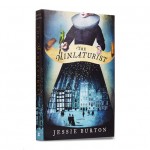 Blogging is all about immediacy, and I love that, though it’s hard when plans are brewing in other less-immedate media that I can’t tell you about for months and months. But I have couple of neat things now. The first is that I reviewed The Miniaturist by Jessie Burton in Chatelaine, which is one of “9 Hot Books to Read in October“. The review is also in the print issue of the magazine, in which you can also read this story about a woman who climbs trees for a living. I enjoyed the book a lot, and it’s receiving some excellent buzz (not just mine).
Blogging is all about immediacy, and I love that, though it’s hard when plans are brewing in other less-immedate media that I can’t tell you about for months and months. But I have couple of neat things now. The first is that I reviewed The Miniaturist by Jessie Burton in Chatelaine, which is one of “9 Hot Books to Read in October“. The review is also in the print issue of the magazine, in which you can also read this story about a woman who climbs trees for a living. I enjoyed the book a lot, and it’s receiving some excellent buzz (not just mine).
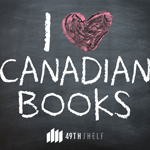 The second thing is that I helped to make this list of 100 Books to Read in a Lifetime for 49th Shelf and amazon.ca, which is a very good answer to the question, “Does Kerry have the best job ever?” So pleased to have come up with a list with favourites and curiosities, which will no doubt irritate people, but we all know that it’s THE definitive list, so no matter. You can also add your own picks to the mix, which is fun. And I do so appreciate anything that gets readers excited about books.
The second thing is that I helped to make this list of 100 Books to Read in a Lifetime for 49th Shelf and amazon.ca, which is a very good answer to the question, “Does Kerry have the best job ever?” So pleased to have come up with a list with favourites and curiosities, which will no doubt irritate people, but we all know that it’s THE definitive list, so no matter. You can also add your own picks to the mix, which is fun. And I do so appreciate anything that gets readers excited about books.
September 29, 2014
May Friedman on Mommyblogs and uncertainty as a valuable critical end
 “In trying to form conclusions about mommybloggers—and about mothers—I am reminded of my children attempting to jump upon their own shadows: I am attempting to trap an essentially untrappable form of knowledge. After the initial discomfort and frustration that this inconclusive conclusion elicits, however, I have found that there is much to gained, as a researcher in general and as a motherhood researcher in particular, in looking instead at uncertainty as a valuable critical lens.” –May Friedman, Introduction, Mommyblogs and the Changing Face of Motherhood
“In trying to form conclusions about mommybloggers—and about mothers—I am reminded of my children attempting to jump upon their own shadows: I am attempting to trap an essentially untrappable form of knowledge. After the initial discomfort and frustration that this inconclusive conclusion elicits, however, I have found that there is much to gained, as a researcher in general and as a motherhood researcher in particular, in looking instead at uncertainty as a valuable critical lens.” –May Friedman, Introduction, Mommyblogs and the Changing Face of Motherhood
This is a kind of criticism that does not pit the critic against the text, does not seek authority. It seeks instead to travel with the work and its ideas, invite it to blossom and invite others into a conversation that might have previously seemed impenetrable, to draw out relationships that might have been unseen and open doors that might have been locked.” —Rebecca Solnit, “Woolf’s Darkness: Embracing the Inexplicable”
It pains me to link to this smug and stupid post I wrote in May 2009, just 11 days before my first child was born. When I purported to understand anything in Rachel Cusk’s A Life’s Work, because I really didn’t. And when I tried to pin down mommybloggers, detailing my discomfort with the form, and my discomfort with that discomfort. I thought I had it all sewed up, because I was surer of things then, and I had no idea of the seas of uncertainty I’d be wading into when it came to mothering, motherhood, and issues around motherhood. Five years later, The M Word was to be partly my means of coming to terms with the beauty of the mess of it all—when in doubt, make an anthology.
When, three months after that embarrassing 2009 blog post, I reviewed the book Mothering and Blogging: The Radical Act of the Mommy Blog by May Friedman and Shana Calixte, my thinking had evolved somewhat, but I was still pretty stupid. (This is the curse of any blogger: you are forever presented with undeniable evidence that you were pretty stupid. And that mostly likely you still are.) But I was getting a sense of things—that motherhood and any ideas surrounding motherhood refused to stay put in my tidy pat conclusions, and that there were many women who didn’t want even them to.
May Friedman’s new book, Mommyblogs and the Changing Face of Motherhood, occurs at a pivotal intersection in my writing life. Outside of my blog, it is my writing about motherhood and my mothering life that has found most resonance with readers, so much so that when a recent published story contained nary a reference to mothers anywhere, I was a bit relieved. And I’ve also been blogging for 14 years this October, which has led to the opportunity to teach the course, The Art of Blogging, at the University of Toronto (whose latest session starts a week from tonight!). In my blog teaching, I embrace and celebrate the messy chaos of the blog form, as unpindownable as mothers are. (You can read my posts with thoughts on blogging here.) I welcomed the reflections, revelations and insights of Mommyblogs and the Changing Face of Motherhood not just for what they had to say about mothers and mommyblogs, but for the perspective the book provided on the history and implications of the blogosphere with a lens on women (who, as in any history, are so often left out of the story).
True confession: I have an allergy to Foucault, and once they start referencing Bahktin, they’ve already lost me. As an academic text, Friedman’s book stands apart from others that I’ve encountered in that her critical framework serves to transform the familiar into something altogether new, rather than rendering it intelligible. In Mommyblogs and the Changing Face of Motherhood, she examines mommyblogs in the frameworks of hybridity (as a form, of the identities of blog authors, of the experiences of readers), cyborgs (of the author and her text via technology, and also of the complex and nuanced networks created through blogging communities, how mothering is reworked away from being an individuated task) and Queer theory (a movement away from the patriarchal institution of motherhood toward an otherness) to show that mommyblogging is indeed a radical act that has already changed the way motherhood is regarded in the public sphere, and whose further implications are still before us, rich with possibility.
It is as applicable to that mythic blogosphere as a whole what Friedman has to say about “the mamasphere”: “It is precisely because it is impossible to say anything generalizable about the mamasphere as a whole that it is a radical maternal space; not as a result of the activism of individual mothers, but because of the implications of all these narratives coexisting, and the endless unspooling dialogue that therefore emerges.” That lack of generalization doesn’t freak me out anymore, and I appreciate Friedman’s excellent book for reminding me why certainty is anathema to everything I like best about the world, both online and off.
See also: “Mary Pratt, On Blogging, and Preserving Light and Time”
September 28, 2014
New Books by The M Word Authors
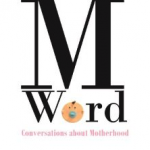 In many ways, it seems impossible to believe that the wondrous reception of The M Word last spring could have ever happened. I still can’t fathom the generosity of both the readers and the writers involved with this project, and I’m so proud of the book itself and the further conversations it has generated since it was published. But a particularly cool experience for me has been seeing elements of the essays at play in their writers’ latest works. If you enjoyed The M Word, I urge you to check out these new books by four writers from the anthology.
In many ways, it seems impossible to believe that the wondrous reception of The M Word last spring could have ever happened. I still can’t fathom the generosity of both the readers and the writers involved with this project, and I’m so proud of the book itself and the further conversations it has generated since it was published. But a particularly cool experience for me has been seeing elements of the essays at play in their writers’ latest works. If you enjoyed The M Word, I urge you to check out these new books by four writers from the anthology.
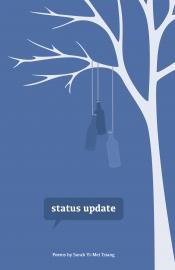 Status Update, by Sarah Yi-Mei Tsiang:
Status Update, by Sarah Yi-Mei Tsiang:
The “book of secrets” referred to in Sarah Yi-Mei Tsiang’s essay, “Mommy Wrote a Book of All My Secrets” was actually this book, Tsiang’s latest book of poetry, which was nominated for the Pat Lowther Award in the spring. It’s a collection of poetry inspired by Facebook status updates, which is only the beginning of what is interesting about this funny, beautiful book and I loved so much when I read it in June.
Between Gods, by Alison Pick:
I’ve not read Between Gods yet—I am hoping to stop by the launch this week and pick up a copy there. But the book has been receiving goods reviews and was a bestseller the week it was released. And I know that Pick’s essay from The M Word, “Robin”, appears in a reworked form in the memoir. I am looking forward to find out how it fits into a larger context.
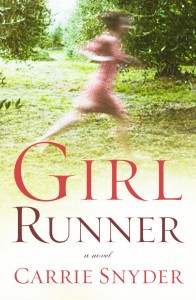 Girl Runner, by Carrie Snyder:
Girl Runner, by Carrie Snyder:
The connections between Snyder’s essay in The M Word, “How to Fall”, and her new novel, Girl Runner, are more oblique, but when I read the book, I couldn’t help but notice Aganetha Smart’s insistence on never falling (which is pretty much gravitationally impossible) in the novel. Girl Runner has been receiving great reviews, and will be published in countries all over the world in 2015.
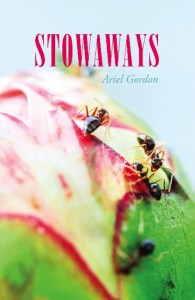 Stowaways, by Ariel Gordon:
Stowaways, by Ariel Gordon:
Gordon’s essay in The M Word, “Primapara”, contains a poem called “Primapara”, which appears also in her new collection, Stowaways. This would be the poem with the immortal line, “If I had had twins, I would have eaten one.” The entire collection is just as mordant and intriguing, the familiar rendered from a whole new point of view.
September 27, 2014
Best Book of the Library Haul: I Like Old Clothes
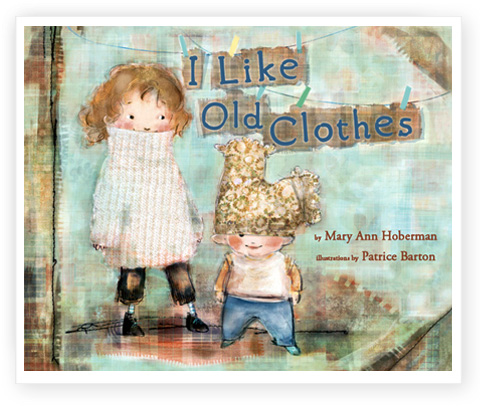 Here is a secret to living well in the city on a salary and a half—we buy all our children’s clothes at Value Village. Which is cheaper than even Wal-Mart, and this way we don’t have to go to Wal-Mart, plus my children get to wear clothes first purchased by people who valued quality, long-lasting, stylish children’s clothing (not Wal-Mart) as much as I do. Everybody wins, but us in particular (and with the money we saved, we go out and buy books).
Here is a secret to living well in the city on a salary and a half—we buy all our children’s clothes at Value Village. Which is cheaper than even Wal-Mart, and this way we don’t have to go to Wal-Mart, plus my children get to wear clothes first purchased by people who valued quality, long-lasting, stylish children’s clothing (not Wal-Mart) as much as I do. Everybody wins, but us in particular (and with the money we saved, we go out and buy books).
So I was quite excited to encounter the picture book I Like Old Clothes by the wonderful Mary-Ann Hoberman, an reissued edition with gorgeous new illustrations by Patrice Barton. It’s a story about the delights of second-hand clothing and hand-me-downs, the treasures discovered and, most importantly, the stories these clothes carry in their threads about all the people who’ve ever worn them and all the places they’ve been.
“‘You lived in East Bend, / Blue Sweater,’ I say. / ‘Just think, you are living / in my town today.’”
It’s an empowering thrifter’s manifesto, a story that gets kids excited about the economical and ecologically sound practice of buying second-hand. A brilliant antidote to rampant messages of consumerism found elsewhere, and the just the thing to make parents and kids feel good about the choices their family makes.

